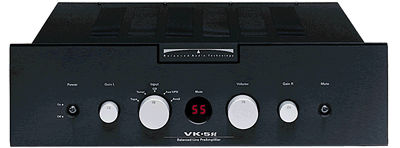| Columns Retired Columns & Blogs |
Balanced Audio Technology VK-5 preamplifier & VK-60/75 power amplifiers Page 2
Technical highlights
A thorough description of the VK-5's and the VK-60's technical designs would require more than a dozen pages of text—which is what BAT has provided in their white papers. Anyone seriously interested in these products should call or write to BAT for copies. (See also the accompanying interview with Victor Khomenko and Steve Bednarski.) I'll restrict my description to the features that I found particularly interesting.
A thorough description of the VK-5's and the VK-60's technical designs would require more than a dozen pages of text—which is what BAT has provided in their white papers. Anyone seriously interested in these products should call or write to BAT for copies. (See also the accompanying interview with Victor Khomenko and Steve Bednarski.) I'll restrict my description to the features that I found particularly interesting.

The VK-5 and the VK-60 are fully balanced (differential) designs; balanced operation is maintained from input to output. However, both are said to be compatible with single-ended components, using simple XLR-to-RCA adapters. (Of course, if you buy BAT's argument, you'll eventually be going for a fully balanced system.)
Both the VK-5 and the VK-60 are pure tube designs, with no solid-state devices in the signal paths. Both are zero-global-feedback designs. The VK-60 white paper recounts that different amounts of global feedback were tried during product development; BAT found that as little as 3dB negative feedback was detrimental to the sound, reducing the size of the soundstage and the sense of air around the human voice. BAT claims that although the VK-60 uses zero negative feedback, this is achieved without degrading test-bench behavior.
The VK-5 and the VK-60 are described as having dual-mono construction. The VK-5 has separate toroidal transformers, power supplies, and input and output boards for each channel; the VK-60 has a single 800VA toroidal power transformer, albeit with separate secondary windings for the left and right channels. (Used as monoblocks, VK-60s are unquestionably of dual-mono construction.)
The VK-60's output transformers are of a wide-bandwidth design, and feature three sets of taps to match speakers of different impedance characteristics. The white papers make much of the VK-60's power supply; suffice it to say that BAT believes in size—14,000µF filter capacitance for the VK-5, 500 joules power-supply energy storage for the VK-60—and in making do with as little voltage regulation feedback as possible.
Cathode followers, or buffers, are commonly used in multistage preamp and amplifier designs; BAT rejects the use of this type of circuit, describing it as creating a "bottleneck" in the system. The VK-5 and the VK-60 use plate-loaded triode circuits throughout, without any type of cathode follower or buffer.
In BAT's view, a critical indicator of a circuit's effectiveness is "signal-path restriction," which is said to be a direct function of the signal path's length (ie, number of stages) and an inverse function of the signal stage's quiescent power (a measure of the stage's "width"). The VK-5's and the VK-60's high-current signal paths, combined with a simple, direct signal path (just a single gain stage in the VK-5, three in the VK-60) are intended to reduce signal-path restriction.
The quest for simplicity extends to the Volume Control, which features the increasingly popular shunt attenuator. (The Genesis Stealth amplifier and the most recent Melos preamp designs are among those using this method.) There's only a single Vishay resistor in the signal path at any point; gain is controlled by "bleeding" some of the signal to ground. The Left/Right gain adjustment controls, also shunt-type, thus are out of the direct signal path [at least in DC terms—Ed.].
The VK-60 is described as a balanced design that's single-ended. No, they don't just mean that it's compatible with single-ended inputs (which it is), but that within the positive and negative "legs" of the balanced circuitry, the tubes are operated in single-ended rather than push-pull manner. To achieve a more substantial output capability than normal for single-ended amplifiers, the VK-60 uses bridging, so VK-60 owners can impress and confuse their audiophile friends by saying that their amp is a "balanced bridged single-ended plate-loaded triode." (Isn't audio jargon wonderful?)
With tube amplifiers, controlling the output tubes' bias voltages is a perennial problem. Some manufacturers simply set bias voltage at the factory and hope it doesn't drift too far as tubes age; others include user-adjustable pots and meter test points or LEDs that indicate when bias has been set correctly. (The slightly compulsive among us are forever checking and tweaking bias voltages.) BAT's approach to this problem is an automatic bias circuit that compensates for mismatching or aging of tubes, as well as for fluctuations of line voltage. Less than a minute after the amp is turned on, a set of LEDs lights up, indicating that the bias on each tube has been optimized and the amp is ready to roll.
When the purely electronic aspects of design are taken care of, vibration control becomes an important consideration. For the VK-5 and the VK-60, BAT selected resistors and capacitors with low sensitivity to vibration and shock, located critical components at or near vibration nodes (where vibration is minimal), and used a chassis with a ½"-thick baseplate, coupling the pcb to the chassis at multiple points. The VK-5's side panels and top cover are made of fairly thin metal, but BAT's position is that this is much less important than the area of the chassis closest to the components: the bottom. This makes sense, but I'd like to see the VK-5 with a more substantial top cover, if only for aesthetic reasons.
- Log in or register to post comments




































